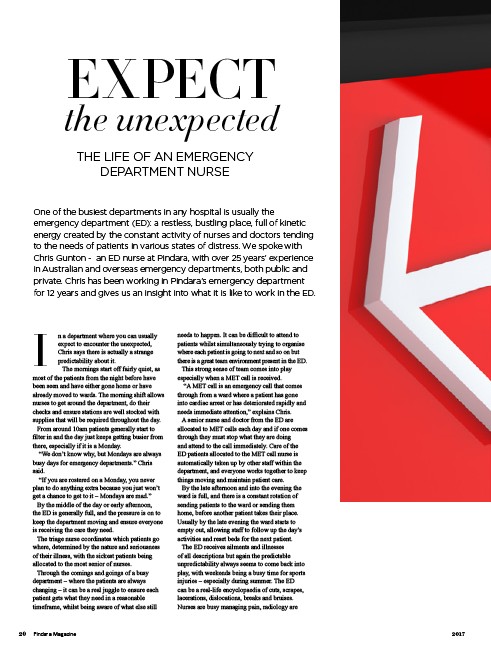
THE LIFE OF AN EMERGENCY
DEPARTMENT NURSE
n a department where you can usually
expect to encounter the unexpected,
Chris says there is actually a strange
predictability about it.
The mornings start off fairly quiet, as
most of the patients from the night before have
been seen and have either gone home or have
already moved to wards. The morning shift allows
nurses to get around the department, do their
checks and ensure stations are well stocked with
supplies that will be required throughout the day.
From around 10am patients generally start to
filter in and the day just keeps getting busier from
there, especially if it is a Monday.
“We don’t know why, but Mondays are always
busy days for emergency departments.” Chris
said.
“If you are rostered on a Monday, you never
plan to do anything extra because you just won’t
get a chance to get to it – Mondays are mad.”
By the middle of the day or early afternoon,
the ED is generally full, and the pressure is on to
keep the department moving and ensure everyone
is receiving the care they need.
The triage nurse coordinates which patients go
where, determined by the nature and seriousness
of their illness, with the sickest patients being
allocated to the most senior of nurses.
Through the comings and goings of a busy
department – where the patients are always
changing – it can be a real juggle to ensure each
patient gets what they need in a reasonable
timeframe, whilst being aware of what else still
needs to happen. It can be difficult to attend to
patients whilst simultaneously trying to organise
where each patient is going to next and so on but
there is a great team environment present in the ED.
This strong sense of team comes into play
especially when a MET call is received.
“A MET call is an emergency call that comes
through from a ward where a patient has gone
into cardiac arrest or has deteriorated rapidly and
needs immediate attention,” explains Chris.
A senior nurse and doctor from the ED are
allocated to MET calls each day and if one comes
through they must stop what they are doing
and attend to the call immediately. Care of the
ED patients allocated to the MET call nurse is
automatically taken up by other staff within the
department, and everyone works together to keep
things moving and maintain patient care.
By the late afternoon and into the evening the
ward is full, and there is a constant rotation of
sending patients to the ward or sending them
home, before another patient takes their place.
Usually by the late evening the ward starts to
empty out, allowing staff to follow up the day’s
activities and reset beds for the next patient.
The ED receives ailments and illnesses
of all descriptions but again the predictable
unpredictability always seems to come back into
play, with weekends being a busy time for sports
injuries – especially during summer. The ED
can be a real-life encyclopaedia of cuts, scrapes,
lacerations, dislocations, breaks and bruises.
Nurses are busy managing pain, radiology are
I
EXPECT
the unexpected
One of the busiest departments in any hospital is usually the
emergency department (ED): a restless, bustling place, full of kinetic
energy created by the constant activity of nurses and doctors tending
to the needs of patients in various states of distress. We spoke with
Chris Gunton - an ED nurse at Pindara, with over 25 years’ experience
in Australian and overseas emergency departments, both public and
private. Chris has been working in Pindara’s emergency department
for 12 years and gives us an insight into what it is like to work in the ED.
20 Pindara Magazine 2017